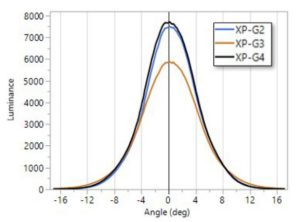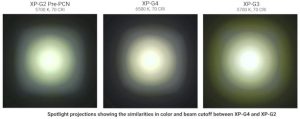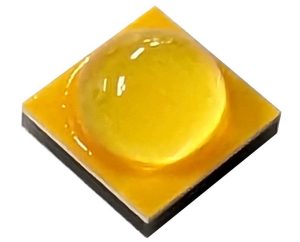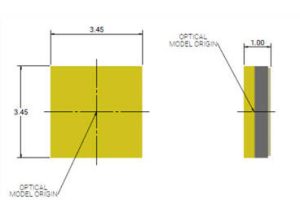
Update: Lens-less ‘high-intensity’ variants were announced in January 2024
It is also harking back to now-unobtainable ‘pre-PCN’ XP-G2 leds – devices made before a manufacturing change that altered beam quality.
“XP-G2 was well-received by customers for its excellent low colour shift from the centre to the outer beam,” according to Cree. “XP-G4 is designed with a flat and smooth phosphor layer to closely-match the colour-over-angle profile of XP-G2. Our data show this similarity in every optic tested.”

Beam patterns with Ledil C17991 SPORT2X2-S1 optic
Does the difference in colour temperature affect intensity? “The performance of XP-G4 would not be significantly different if we used 5,700K CCT vs the 6,500K CCT tested,” Cree told Electronics Weekly
The changes implemented in XP-G4 leds “direct the emitted light into a narrower, more uniform cone, resulting in a view angle of 120° [full-width half-max] in neutral white to closely match pre-PCN XP-G2,” according to Cree. “This is accomplished without changes to the overall dimensions so it can drop in without mechanical interference.”
 In addition: “XP-G4 is more efficient than XP-G2 and, with a higher maximum of 3A, it can deliver 75% more lumens than XP-G2 running at 1.5A, with proper heat sinking.” And G4 will run cooler than G2 “under the same operating conditions”. Thermal resistance, is 1.3°C/W junction to solder point.
In addition: “XP-G4 is more efficient than XP-G2 and, with a higher maximum of 3A, it can deliver 75% more lumens than XP-G2 running at 1.5A, with proper heat sinking.” And G4 will run cooler than G2 “under the same operating conditions”. Thermal resistance, is 1.3°C/W junction to solder point.
The light source size is 2.1 x 2.1mm, down from the 2.3 x 2.3mm of XP-G3 leds (packaging remains 3.45 x 3.45mm). Compared with G3, intensity is up to 69% higher and maximum light output is said to be 41% greater than ‘XP-G3 Standard’ leds, at up to 1,130 lm.
Which versions of each led the above comparisons are made between is not stated, so data sheet diving is recommended if this is important to you.
Colour temperatures from 1,800 to 6,500K will be offered, and colour rendering indices of 70, 80 or 90 – but not every temperature will be available with every CRI. “Additionally, ‘television lighting consistency index’ [TLCI] will be offered”, said Cree.
High light quality ‘Pro9’ branded G4 version (others above are branded ‘Standard’ compared with these) with a maximum current of 2A and maximum output of 695 lm will be offered, at 90 and 95+ CRIs and colour temperatures of 4,000, 3,500, 3,000 or 2,700K. There are no 95+ Standard parts.
Typically, G4 forward voltage will be 2.8V at 700mA 85°C (3.3Vmax). Other typical 85°C values are: 2.92 (1A), 3.14 (2A) and 3.32 (3A). Continuous 3A operation at 105°C is possible if junction to ambient resistance can be kept below 5°C/W.
Samples are available through Digikey or Mouser, or Cutter Electronics in Australia, and production quantities from Arrow (Americas EMEA) or WPGA (Americas).
The XP-G4 product page can be found here, the data sheet for Standard versions here, and Pro9 data sheet here
‘XP-G4 LED Design Guide‘ is an excellent document that details beam characteristics in comparison with earlier XP-Gs.
For a summary of colour temperature and CRI combinations available, see page two of this document.
Note: pre-PCN XP-G2 leds were manufactured before the changes described in 13 April 2021 document CreeLED-PCN-5146.
XP-G4 photo by Cutter Electronics
 Electronics Weekly Electronics Design & Components Tech News
Electronics Weekly Electronics Design & Components Tech News


